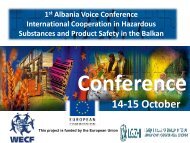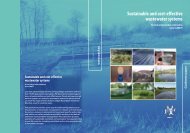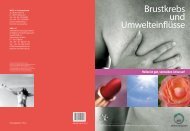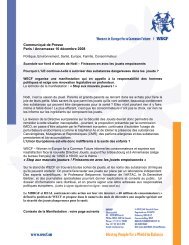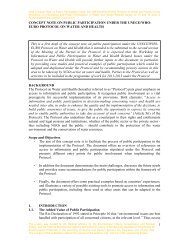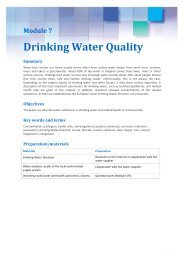Local Action for Safe Water - WECF
Local Action for Safe Water - WECF
Local Action for Safe Water - WECF
You also want an ePaper? Increase the reach of your titles
YUMPU automatically turns print PDFs into web optimized ePapers that Google loves.
Though our planet is covered by 71% of water, only a fraction can be used as drinking water (Table 1).<br />
A <strong>WECF</strong> publication 2012<br />
<strong>Water</strong> volume [km³] Percentage [%]<br />
Total 1 384 120 000 100,00<br />
Saltwater (sea) 1 348 000 000 97,39<br />
Freshwater (total) 36 020 000 100 2,60<br />
Freshwater<br />
<strong>Water</strong> in polar ice, sea ice, glaciers 27 820 000 77,23 2,01<br />
Groundwater, soil moisture 8 062 000 22,38 0,58<br />
<strong>Water</strong> in rivers and lakes 127 000 0,35 0,01<br />
water in the atmosphere 13 000 0,04 0,001<br />
Table 1: <strong>Water</strong> volume of the earth<br />
Source: Marcinek & Rosenkranz 1996, Data according to Baumgartner und Reichel 1975;<br />
bfw.ac.at/300/pdf/globaler_wasserkreislauf.pdf<br />
Only 1% of all freshwater can be used as drinking water! This is an equivalent of 0,0026% of the total water<br />
volume!<br />
To make this a little bit more quantifiable here is a comparison:<br />
If a bath tub is full of water (150l) and this stands <strong>for</strong> the whole water reservoir of our world than roughly 4,2l<br />
(½ bucket) are freshwater and of these<br />
• 3,2l are ice (poles and glaciers)<br />
• 1l is groundwater and only<br />
• 0,02l (a brandy glass) are surface water bodies (lakes, rivers)<br />
• 0,004l (a thimble!!) are theoretically usable as drinking water<br />
3. Experiments and questions<br />
Build your own water filter<br />
• Cut the bottom of the plastic bottle. Turn it around (the cap is now at the bottom), put charcoal in first,<br />
then silt and add some gravel at the top.<br />
• Create some “dirty water” (soil + water and stir it)<br />
• Remove the cap of the bottle and place the bottle on a glass. Fill some of the dirty water into the bottle<br />
which is now the filter and see what happens. How does the dropping water look like?<br />
• Fill one bottle with pure garden soil and one with clay as explained above. Put some water on the top of<br />
the soils and observe what happens. Try to explain why.<br />
WSP related activities<br />
• Which types of water sources are found in the local environment?<br />
• In which geographical situation is the local area situated?<br />
• Which soil layers are found and how do they protect the water?<br />
• Which source is the drinking water taken from? How deep is the source?





